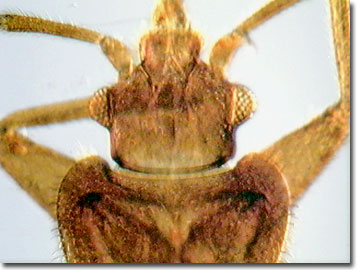Oblique Digital Image Gallery
Bedbug (Cimex lectularius)
To some, the nightly warning from caring parents of "Don't let the bedbugs bite" means more than sleep tight. Bedbugs, comprising 30 known species worldwide, are small, blood-sucking insects from the family Cimicidae in the order Hemiptera, or true bugs. As with other hemipterans, sucking mouthparts enable the feeding bedbugs to pierce the host's tissues and siphon out, in this case, a blood meal.

Usually only about 6 millimeters in length, bedbugs are flat, oval, wingless and reddish brown insects that announce their infestations with odoriferous oily secretions, which are emitted from two glands on their undersides. The common human bedbug, Cimex lectularius, is mostly nocturnal, spending the daytime in furniture upholstery, bed linens, and wall crevices. Although humans are its primary host, the human bedbug will occasionally feast on other mammals or chickens. Unlike many parasites depending on blood meals, the common human bedbug can live up to one year without feeding and is not known to transmit diseases. A substance in the saliva of a bedbug keeps the blood from clotting while the bug feeds on its human host, analogous to feeding by mosquitoes, leeches, and endoparasites.
Under warm environmental conditions, the life cycle of the common human bedbug, from fertilized egg to mature adult, takes about two months, with three or even four generations occurring every year. A related species, C. hemipterus, is a common Old World tropical human parasite, while another North American species, Haematosiphon inodora may also bite humans, but primarily feeds on poultry. Other species of bedbugs attack bats and birds. For bedbugs, steaming, spraying, and fumigating bedding, furniture, and walls may provide some control and relief from the itching and skin irritations associated with their bites. Often, improved sanitation is the best solution for this irritating, but not deadly entomological infestation.
Contributing Authors
Cynthia D. Kelly, Thomas J. Fellers and Michael W. Davidson - National High Magnetic Field Laboratory, 1800 East Paul Dirac Dr., The Florida State University, Tallahassee, Florida, 32310.
BACK TO THE OBLIQUE IMAGE GALLERY
BACK TO THE DIGITAL IMAGE GALLERIES
Questions or comments? Send us an email.
© 1995-2025 by Michael W. Davidson and The Florida State University. All Rights Reserved. No images, graphics, software, scripts, or applets may be reproduced or used in any manner without permission from the copyright holders. Use of this website means you agree to all of the Legal Terms and Conditions set forth by the owners.
This website is maintained by our
Graphics & Web Programming Team
in collaboration with Optical Microscopy at the
National High Magnetic Field Laboratory.
Last Modification Friday, Nov 13, 2015 at 01:19 PM
Access Count Since September 17, 2002: 32436
Visit the website of our partner in introductory microscopy education:
|
|
